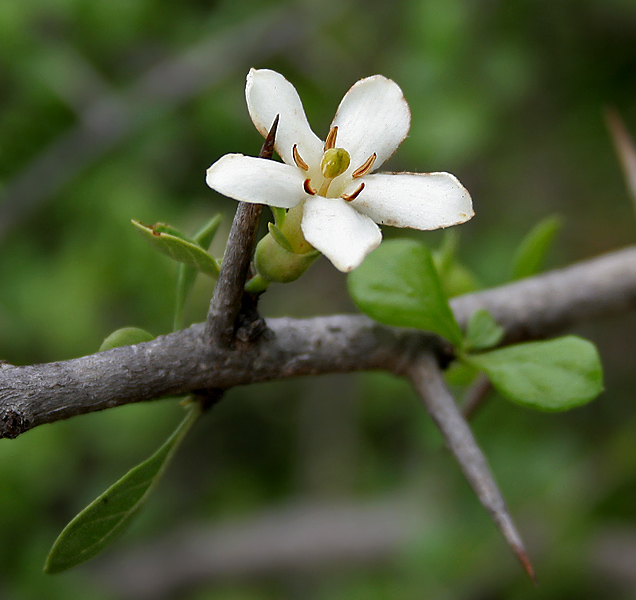Classification System: APG IV
Superregnum: Eukaryota
Regnum: Plantae
Cladus: Angiosperms
Cladus: Eudicots
Cladus: Core eudicots
Cladus: Asterids
Cladus: Lamiids
Ordo: Gentianales
Familia: Rubiaceae
Subfamilia: Ixoroideae
Tribus: Gardenieae
Genus: Catunaregam
Species: Catunaregam spinosa
Name
Catunaregam spinosa (Thunb.) Tirveng., Bull. Mus. Natl. Hist. Nat., Sér. 3, Bot. 35: 13. 1978.
Synonymy
Basionym
Gardenia spinosa Thunb., Gardenia: 16. 1780.
Homotypic
Randia spinosa (Thunb.) Poir., Encycl. [J. Lamarck & al.] Suppl. 2(2): 829. 1812. – non Randia spinosa (K.Schum.) Loes., Verh. Bot. Vereins Prov. Brandenburg 65: 109. 1923, nom. illeg. hom.
Xeromphis spinosa (Thunb.) Keay, Bull. Jard. Bot. État Bruxelles 28: 37. 1958.
Catunaregam spinosa (Thunb.) Tirveng., Taxon 27(5–6): 515. 1978 [1979], isonym
Heterotypic
Bertuchia speciosa Dennst. ex Kostel., Allg. Med.-Pharm. Fl. 5: 2002 (-2003). 1836.
Gardenia dumetorum Retz., Observ. Bot. 2: 14. 1781.
Randia dumetorum (Retz.) Poir., Encycl. Suppl. 2: 829. 1812.
Xeromphis retzii Raf., Sylva Tellur. 21. 1838, nom. illeg.
References
USDA, ARS, Germplasm Resources Information Network. Catunaregam spinosa in the Germplasm Resources Information Network (GRIN), U.S. Department of Agriculture Agricultural Research Service. Accessed: 07-Oct-06.
Vernacular names
मराठी: गेळa=மருக்காரை
Catunaregam spinosa, the mountain pomegranate, is a flowering plant in the family Rubiaceae, found in South Asia and other Asian countries. Almost all parts of the plant are used as a traditional medicine in Ayurveda and fruits have been reported to be used in medicine as well as in food. Various flavonoids, alkaloids, tannins, lignans, terpenoids, and volatile oils have been reported from this plant. Several studies have reported the modern pharmaceutical activities of C. spinosa such as piscicidal, molluscicidal, antioxidant, anti-inflammatory, antidiabetic, and antihyperlipidemic activities [2]
Culture
Known as "කුකුරුමාන් - kukuruman" in Sinhala,"karai"(காரை) in Tamil and "Madanphal or Mainphal" in Nepali.
Known as "Manga/Manga Tree"(మంగ/మంగచెట్టు and పిండీతకము) in Telugu speaking regions of Andhra Pradesh and Telangana. మంగ used to be a commonly held first name for many women in this region. There were films like Mangamma Sapatham, Mangamma gari Manavaraalu, Mangamma gaari manavadu, ganga manga, and many local plays with the name మంగ given to the female protagonist.
Known as "गेळफळ"- gelphal or "पहील्या दिवशीचे फळ" translate as "first days flower" (as it appears white at first) and next day when it turns yellow it called "second days flower" (दुसर्या दिवशीचे फळ) in Marathi.
The Lepcha of Sikkim call it rung gaong koong.[3]
References
"Catunaregam spinosa (Thunb.) Tirveng. | Plants of the World Online | Kew Science".
Timalsina, Deepak; Devkota, Hari; Bhusal, Deepti; Sharma, Khaga (2021). "Catunaregam spinosa (Thunb.) Tirveng: A Review of Traditional Uses, Phytochemistry, Pharmacological Activities, and Toxicological Aspects". Evidence-Based Complementary and Alternative Medicine. 2021: 1–10. doi:10.1155/2021/3257732. PMC 8413030. PMID 34484388.
Tamsang, K.P. (1980). The Lepcha-English Encyclopaedic Dictionary. Kalimpong: Mrs. Mayel Clymit Tamsang. p. 747. ISBN 9632535979.
External links
"Catunaregam spinosa | Species | India Biodiversity Portal". indiabiodiversity.org. Retrieved 2014-08-31.
"Catunaregam spinosa - Mountain Pomegranate". flowersofindia.net. Retrieved 2014-08-31.
"Catunaregam spinosa (Thunb.) Tirveng. — The Plant List". theplantlist.org. Retrieved 2014-08-31.
Kulakkattolickal, Augusthy Thevasia (1989). "Piscicidal plants of Nepal: Ripe fruit of Catunaregam spinosa (Thunb.) (Rubiaceae) and leaves of Polygonum hydropiper L. (Polygonaceae) as fish poisons". Aquaculture. 78 (3–4): 293–301. doi:10.1016/0044-8486(89)90107-5.
Dressler, S.; Schmidt, M. & Zizka, G. (2014). "Catunaregam spinosa". African plants – a Photo Guide. Frankfurt/Main: Forschungsinstitut Senckenberg.
Retrieved from "http://en.wikipedia.org/"
All text is available under the terms of the GNU Free Documentation License


